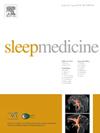Impact of age on sleep duration and health outcomes: Evidence from four large cohort studies
IF 3.8
2区 医学
Q1 CLINICAL NEUROLOGY
引用次数: 0
Abstract
Background
Sleep duration (SD) is a critical determinant of health, with both short and long SD associated with increased risks of morbidity and mortality. However, distinct ages may exhibit unequal sleep needs. Few studies have addressed the modulation of age on SD associated all-cause mortality (AM). This study aimed to investigate age- and gender-specific associations between SD and AM.
Methods
Four national cohort studies were conducted: National Health and Nutrition Examination Survey (NHANES), Survey of Health, Ageing and Retirement in Europe (SHARE), Chinese Longitudinal Healthy Longevity Survey (CLHLS), and China Health and Retirement Longitudinal Study (CHARLS). Data pre-processing such as integration, weighting and interpolation was conducted following cohort-specific user manuals. Restricted cubic spline (RCS) was used to test the nonlinear relationship. Kaplan-Meier and Cox regression survival analysis were used to evaluate the association between SD and AM. The moderation of mortality by SD was subsequently investigated in adult, middle-age, elderly and longevity.
Results
RCS analysis showed a nonlinear correlation between SD and AM in the four cohorts(P < 0.001). Survival analysis reveals 6–8 h to be the optimal SD. Subgroup analyses showed a higher risk in adults with ≤5 h than ≥9 h (HR: 2.95 [1.90–4.59] vs 1.83 [1.08–3.12]), and a similar risk in middle age (HR: 2.42 [1.76–3.32] vs 2.44 [1.64–3.61]). In contrast, four datasets suggest a higher risk of the elderly being affected by long SD. Adults (HR = 1.82 [1.14–2.92], P = 0.012) and middle age (NHANES: HR = 1.50 [1.04–2.16], P = 0.029; SHARE: HR = 3.04 [1.10–8.41], P = 0.032) significantly increased the risk of short sleep compared to elderly.
Conclusions
SD associated mortality risk varies with age. Young adults should avoid poor sleep, while elderly should avoid sleeping too much.
求助全文
约1分钟内获得全文
求助全文
来源期刊

Sleep medicine
医学-临床神经学
CiteScore
8.40
自引率
6.20%
发文量
1060
审稿时长
49 days
期刊介绍:
Sleep Medicine aims to be a journal no one involved in clinical sleep medicine can do without.
A journal primarily focussing on the human aspects of sleep, integrating the various disciplines that are involved in sleep medicine: neurology, clinical neurophysiology, internal medicine (particularly pulmonology and cardiology), psychology, psychiatry, sleep technology, pediatrics, neurosurgery, otorhinolaryngology, and dentistry.
The journal publishes the following types of articles: Reviews (also intended as a way to bridge the gap between basic sleep research and clinical relevance); Original Research Articles; Full-length articles; Brief communications; Controversies; Case reports; Letters to the Editor; Journal search and commentaries; Book reviews; Meeting announcements; Listing of relevant organisations plus web sites.
 求助内容:
求助内容: 应助结果提醒方式:
应助结果提醒方式:


